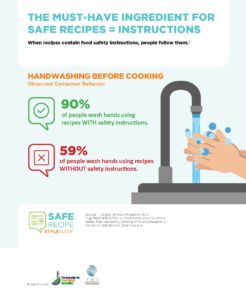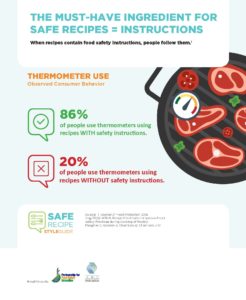National Food Safety Month
go.ncsu.edu/readext?737336
en Español / em Português
El inglés es el idioma de control de esta página. En la medida en que haya algún conflicto entre la traducción al inglés y la traducción, el inglés prevalece.
Al hacer clic en el enlace de traducción se activa un servicio de traducción gratuito para convertir la página al español. Al igual que con cualquier traducción por Internet, la conversión no es sensible al contexto y puede que no traduzca el texto en su significado original. NC State Extension no garantiza la exactitud del texto traducido. Por favor, tenga en cuenta que algunas aplicaciones y/o servicios pueden no funcionar como se espera cuando se traducen.
Português
Inglês é o idioma de controle desta página. Na medida que haja algum conflito entre o texto original em Inglês e a tradução, o Inglês prevalece.
Ao clicar no link de tradução, um serviço gratuito de tradução será ativado para converter a página para o Português. Como em qualquer tradução pela internet, a conversão não é sensivel ao contexto e pode não ocorrer a tradução para o significado orginal. O serviço de Extensão da Carolina do Norte (NC State Extension) não garante a exatidão do texto traduzido. Por favor, observe que algumas funções ou serviços podem não funcionar como esperado após a tradução.
English
English is the controlling language of this page. To the extent there is any conflict between the English text and the translation, English controls.
Clicking on the translation link activates a free translation service to convert the page to Spanish. As with any Internet translation, the conversion is not context-sensitive and may not translate the text to its original meaning. NC State Extension does not guarantee the accuracy of the translated text. Please note that some applications and/or services may not function as expected when translated.
Collapse ▲National Food Safety Month (NFSM) is the one month out of the year dedicated to food safety education. Did you know that roughly one in six people get sick from a foodborne illness in the United States each year and much of this can be prevented? The way recipes are written can help people keep food safety in mind.
Researchers at Tennessee State University watched people cook and found that when recipes contain food safety instructions, people follow them. Here are a couple examples: 59% of the people washed their hands before cooking. When they added hand washing as part of the recipe 90% washed first. The results were even more dramatic when the recipe included instructions for using a food thermometer. The study showed that only 20% of people used food thermometers when using recipes WITHOUT safety instructions and 86% used thermometers when given recipes WITH safety instructions.
Both hand washing before cooking and using a thermometer are two easy ways to increase the safety of the food you cook.
Most of you are probably not food writers or food bloggers and not writing recipes. But, many of you are parents or grandparents that are teaching young people how to cook. Sometimes this is done just by them watching what you do in a kitchen.
Be a good role model and use good food safety practices in the kitchen.
For info on National Food Safety Month and writing food safe recipes go to the Partnership for Food Safety Education
Source: Cheryle Jones Syracuse, Family and Consumer Science staff member Cheryle_Syracuse@ncsu.edu





